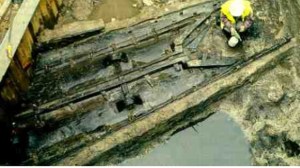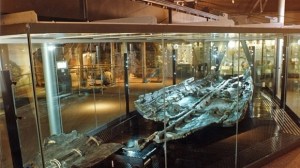he Dover Boat is one of Britain’s great under-appreciated ancient artefacts.
Older than the Roman Empire. Older than Moses. It would have been in the water at the same time Stonehenge was in use. That’s about 1500 BC – 3,500 years ago.

The Dover Boat after it was discovered in 1992 Photo: Dover Museum
There would have been countless others like it of course but they have not survived. Built from planks of oak, stiched together with pieces of yew. Certainly not meant to last thousands of years, which is why the vast majority have disappeared.
So to have found one – or at least seventy per cent of one – and to have preserved and displayed it is nothing short of miraculous. There are boats or fragments of boats which may well be older; the Abydos fleet of Egypt for example or the pine canoes of China’s Zhejiang province. And wood found off the Hampshire coast at Hayling Island in the late 1990s has been carbon dated to 7,000 years ago.
What makes Dover’s boat special though is that so much of it can still be seen and appreciated thanks to a huge rescue and conservation effort.
When it was first discovered during roadworks in Dover town centre it stunned archaeologists. But every hour the timbers were exposed it was effectively rotting away. And so teams of historians and archaeologists swung into action by the roadside. The boat was cut into sections, measured, recorded and cleaned. The bits were taken to a shed in Dover Harbour where they were kept wet in large and hastily-constructed water tanks. Later the ancient wood was strengthened using liquid wax, freeze-dried at the Mary Rose Trust in Portsmouth and finally put back together using an adjustable crane.

The preserved Bronze Age Boat in Dover Museum Credit: Dover Museum
The Dover Boat is one of Britain’s great under-appreciated ancient artefacts.
Older than the Roman Empire. Older than Moses. It would have been in the water at the same time Stonehenge was in use. That’s about 1500 BC – 3,500 years ago.
There would have been countless others like it of course but they have not survived. Built from planks of oak, stiched together with pieces of yew. Certainly not meant to last thousands of years, which is why the vast majority have disappeared.
So to have found one – or at least seventy per cent of one – and to have preserved and displayed it is nothing short of miraculous. There are boats or fragments of boats which may well be older; the Abydos fleet of Egypt for example or the pine canoes of China’s Zhejiang province. And wood found off the Hampshire coast at Hayling Island in the late 1990s has been carbon dated to 7,000 years ago.
What makes Dover’s boat special though is that so much of it can still be seen and appreciated thanks to a huge rescue and conservation effort.
When it was first discovered during roadworks in Dover town centre it stunned archaeologists. But every hour the timbers were exposed it was effectively rotting away. And so teams of historians and archaeologists swung into action by the roadside. The boat was cut into sections, measured, recorded and cleaned. The bits were taken to a shed in Dover Harbour where they were kept wet in large and hastily-constructed water tanks. Later the ancient wood was strengthened using liquid wax, freeze-dried at the Mary Rose Trust in Portsmouth and finally put back together using an adjustable crane.
Then came another battle – to keep the Dover Boat where it belonged. A world-famous museum was said to have bid for it but had the idea of keeping it in pieces. In the end there was a massive fund-raising initiative and a great gallery was built in Dover Museum with a sealed glass chamber that now keeps the precious object safe in perpetuity.
And all the time historians have been looking at it, examining it, working out how it was built.
Seeing how it would have been hewn from the timbers of mighty trees that would have grown all the way down to the shoreline back then.
Seeing how it would not have had a sail, perhaps not even a rudder. Difficult to tell because the back of the boat is missing.
Seeing how it would have been rowed by about a dozen men using huge oars.
Maybe they wave-tested it off the Kent coast. Maybe it pootled upriver. Debate has raged over whether the Dover Boat was robust enough to have taken to the seas and therefore establish a claim to be one of the world’s oldest surviving seagoing vessels.
It or something like it would surely have rowed along the coast of Southern Britain, hugging the coastline in case it shipped too much water. How can we say that? What evidence do we have to back this up?
Well there are artefacts found in Dover from this time period from as far away as Dorset. Logical to think of them having been brought by sea rather than carried overland in what would have been a cumbersome and time-consuming journey.
And so above and beyond all the theories about why and how our boat was built emerges a tantalising possibility.
That it was put together by people who did not just have skills passed down over a few generations, but boat-building knowledge accrued in their communities over hundreds if not thousands of years.
That something very similar to our rickety-looking, oak-planked, yew-stitched craft was crossing the English Channel and also the oceans way back in Stone Age times.
Imagine what light that would cast on our knowledge of the spread and dispersment of peoples, societies, cultures, even entire civilisations, in that yawning chasm of time before recorded history.
The Dover Boat is that significant. A rare treasure.
Article from ITV News: http://www.itv.com/news/meridian/2012-05-12/dover-boat-personal-view/
The Best Guided Tours in British History
HisTOURies UK
Read Full Post »





![image: [ Morris men making merry ]](https://i0.wp.com/news.bbc.co.uk/olmedia/85000/images/_86133_morris_dancers300.jpg)
![[ image: The maypole was a symbol of fertility]](https://i0.wp.com/news.bbc.co.uk/olmedia/85000/images/_86133_mayday_150.gif)
